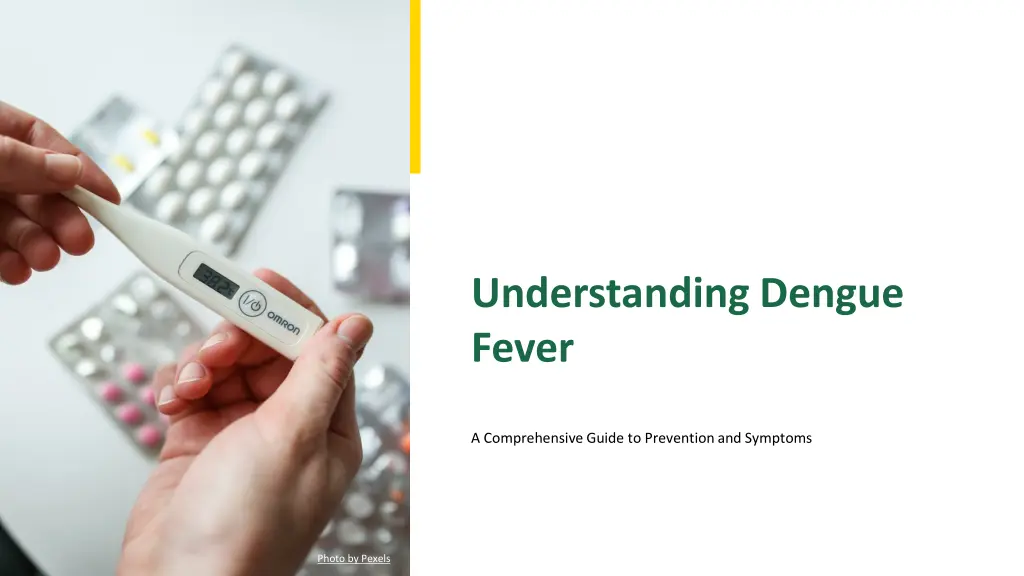
Comprehensive Guide to Dengue Fever: Prevention, Symptoms & More
Discover key information on dengue fever, including prevention strategies, symptom recognition, impact on public health, and challenges in control efforts. Learn how to stay safe and informed about this mosquito-borne illness prevalent in tropical regions.
Download Presentation

Please find below an Image/Link to download the presentation.
The content on the website is provided AS IS for your information and personal use only. It may not be sold, licensed, or shared on other websites without obtaining consent from the author. If you encounter any issues during the download, it is possible that the publisher has removed the file from their server.
You are allowed to download the files provided on this website for personal or commercial use, subject to the condition that they are used lawfully. All files are the property of their respective owners.
The content on the website is provided AS IS for your information and personal use only. It may not be sold, licensed, or shared on other websites without obtaining consent from the author.
E N D
Presentation Transcript
Understanding Dengue Fever A Comprehensive Guide to Prevention and Symptoms Photo by Pexels
01 Introduction to Dengue Table of Contents 02 Defining Dengue Fever 03 Preventing Dengue 04 Recognizing Symptoms 05 Dengue in Tropical Regions 06 Impact on Public Health 07 Research and Innovations 08 Community Involvement 09 Challenges in Dengue Control 10 Future Outlook 11 Conclusion 12 Q&A Session
1 Introduction to Dengue An Overview of the Mosquito-Borne Illness Dengue fever is a mosquito-borne illness prevalent in tropical and subtropical regions. Dengue affects millions worldwide, causing significant health and economic burdens. The disease is primarily spread through the bites of infected Aedes mosquitoes. Understanding dengue is crucial for prevention and control efforts. Photo by Pexels
2 Defining Dengue Fever Key Characteristics and Facts Dengue is caused by four closely related viruses, known as DENV-1, DENV-2, DENV-3, and DENV-4. Symptoms range from mild fever to severe dengue, which can be life-threatening. Dengue is diagnosed through clinical evaluation and laboratory tests. There is no specific treatment, but supportive care can help manage symptoms. Photo by Pexels
3 Preventing Dengue Strategies to Reduce Risk Eliminating mosquito breeding sites is crucial for prevention. Using insect repellent and wearing protective clothing can reduce mosquito bites. Community-based programs can effectively reduce mosquito populations. Vaccines are available in some regions to prevent dengue infection. Photo by Pexels
4 Recognizing Symptoms Identifying Dengue Fever Early Early symptoms include high fever, headache, and joint pain. Severe dengue can cause bleeding, organ impairment, and plasma leakage. Immediate medical attention is needed for severe symptoms. Most people recover within a week, but severe cases require hospitalization. Photo by Pexels
5 Dengue in Tropical Regions Why It's Prevalent in Certain Areas Warm, humid climates are ideal for mosquito breeding. Rapid urbanization contributes to increased mosquito habitats. Global travel and trade facilitate the spread of dengue. Limited resources in affected regions hinder control efforts. Photo by Pexels
6 Impact on Public Health Dengue's Burden on Healthcare Systems Dengue outbreaks strain healthcare resources and increase costs. The disease affects productivity and economic growth in affected areas. Dengue can lead to social disruption and affect quality of life. International efforts aim to reduce dengue's impact worldwide. Photo by Pexels
7 Research and Innovations Advancements in Dengue Control Ongoing research focuses on developing effective vaccines. Innovative methods like genetically modified mosquitoes are being explored. New diagnostic tools aim to improve early detection and treatment. Global partnerships are essential for advancing research. Photo by Pexels
8 Community Involvement The Role of Public Participation Educating communities about dengue prevention is vital. Community volunteers can help in mosquito control efforts. Local authorities play a key role in implementing control measures. Highlighting successful community programs can inspire others. Photo by Pexels
9 Challenges in Dengue Control Overcoming Obstacles to Eradication Mosquito resistance to insecticides poses a significant challenge. Changing climate patterns affect mosquito distribution and disease spread. Limited resources in affected areas hindereffective control. Effective policies and regulations are needed for sustainable control. Photo by Pexels
10 Future Outlook The Path Towards Dengue Eradication Exploring new technologies and methods for dengue control. International cooperation is crucial for successful eradication. Implementing sustainable practices ensures long-term success. With continued efforts, dengue eradication is achievable. Photo by Pexels
11 Conclusion Summarizing Key Points Awareness and education are key to prevention and control. Preventive measures can significantly reduce dengue cases. Community involvement is essential for successful control efforts. Encourage everyone to participate in dengue prevention initiatives. Photo by Pexels
12 Q&A Session Addressing Audience Queries Answering frequently asked questions about dengue. Providing expert opinions on dengue-relatedtopics. Engaging the audience in a discussion about dengue. Collecting feedback to improve future presentations. Photo by Pexels
